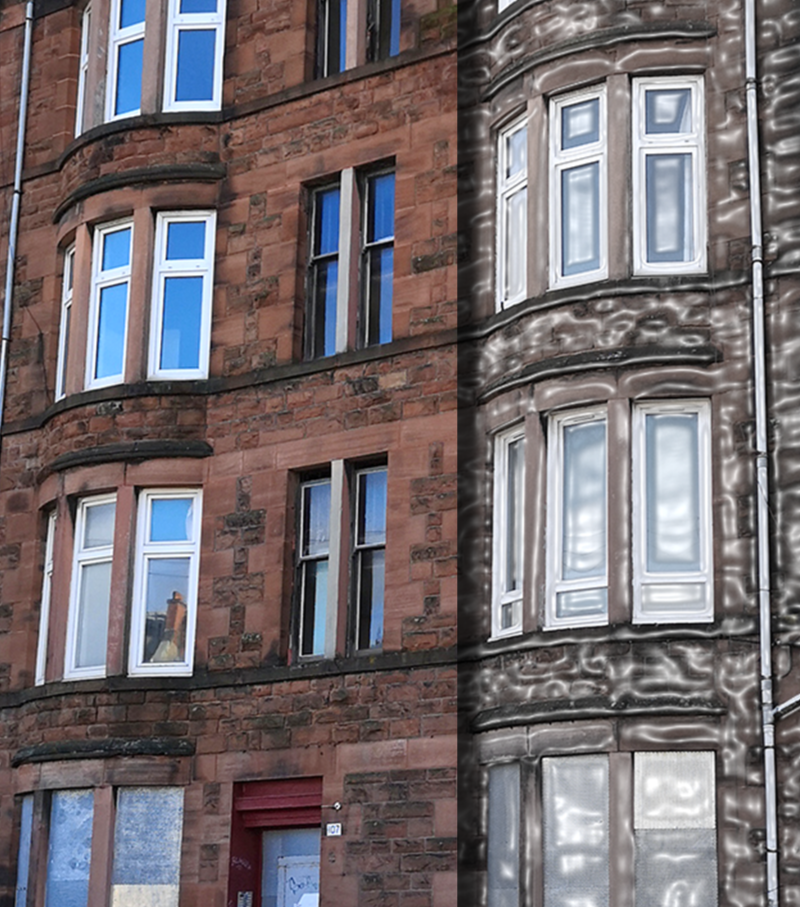
Pre-1919 Niddrie Road Retrofit – An Example of Care for Climate and Health
Created on 15-11-2024
The term 'retrofit' remains a subject of debate, often used interchangeably with 'refurbishment' and 'renovation', lacking a clear distinction. Linguistically, the Oxford English Dictionary (2023) defines 'retrofit' as:
"A modification made to a product or structure to incorporate changes and developments introduced since manufacture or construction; the action or fact of modifying a product or structure in this manner. Also figurative. Concerning buildings, in later use, often implying (an instance of) the making of adaptations to improve energy efficiency or to counteract or mitigate the effects of climate change."
For buildings, retrofit encompasses substantial physical modifications made to them. These changes can stem from two kinds of activities: mitigating activities aimed at improving energy efficiency and adaptive activities, often referred to as 'adaption', involving interventions such as adjustments, reuse or upgrades to align the building with new requirements or conditions (Dixon, 2014).
The retrofitting process of this old tenement at 107 Niddrie Road involved activities for various purposes. For instance, external activities included preserving the aesthetic appearance and heritage of Glasgow's iconic housing typology. The internal activities included repairing all services, including urgent maintenance for timber elements and structural enhancements for future residents' safety.
The retrofitting decisions were also made as a response to the pressing demands of climate change and the future needs of residents. However, these decisions were primarily based on the expertise of the landlord (the housing association), architects, and the Passivhaus enerPHit standard rather than the active involvement of the future occupants (see RE-DWELL blogpost Retrofit and Social Engagement).
In this case study, we will only focus on three primary goals of the retrofitting process: low energy consumption, low carbon emissions, and ensuring the health and wellbeing of future dwellers.
Low energy consumption
The 107 Niddrie Road is an example of how to tackle fuel poverty among dwellers living in this type of historic housing stock. In Scotland, approximately 30% of families living in traditional tenements (equivalent to 175,000 homes) are considered to be fuel poor. The substandard housing conditions of old tenements make it challenging to maintain indoor warmth. Consequently, a substantial portion of a family's income is allocated to energy bills, exacerbating fuel poverty.
The retrofit involved implementing several energy measures aligned with the Passivhaus enerPhit standard to enhance the tenement's energy efficiency. The architects of John Gilbert expect these measures to result in slashing heating costs by up to 90%. Therefore, this retrofit can be considered a deep energy retrofit. Deep energy retrofit provides up to 60 % energy savings by upgrading the building using "a combination or "package" of multiple energy measures that upgrade the physical fabric, heat generation system and lighting of a building" (Page 3, Saffari & Beagon, 2022). The adopted energy measures for this deep energy retrofit included:
1) Retrofitting the fabric: It involved insulating walls, roof, and ground floor, installing triple-glazed windows, and ensuring airtightness to minimise thermal bridging. The retrofit also guaranteed a continuous airtightness line, including all key junctions at the attic level, windows, and doors.
2) Use of Waste Water Heat Recovery (WWHR) system: This system heats cold water using heat recovered from shower or bath drain water. This method significantly reduces hot water costs and carbon emissions by approximately 40%. Given that heating water represents the second largest cost of a fuel bill, this system is expected to substantially reduce these costs and carbon emissions.
3) Individual Air Source Heat Pumps (ASHP): These units were installed in the four flats on the lower floors. In parallel, efficient combi gas boilers were set up in the remaining flats to compare their performance with ASHP during residents' occupancy.
Low carbon emissions
Various measures, including the installation of ASHP and WWHR systems and the utilisation of natural materials, were implemented in a bid to reduce carbon emissions and combat climate change. The project minimised its environmental impact using fewer new materials than new construction blocks. The UK Collaborative Centre for Housing Evidence is currently evaluating the extent of the carbon reduction achieved through these measures.
Ensuring health and wellbeing
By adopting the Passivhaus enerPHit standard, the project prioritised occupant comfort, indoor air quality, and energy efficiency. Expected benefits include:
1) Thermal comfort and reduced energy costs: The retrofit project aimed to maintain warmth during winter and coolness in summer, thereby reducing energy costs, improving residents' quality of life, and minimising temperature-related stress amid rising energy expenses and extreme temperature fluctuations.
2) Damp and mould mitigation for indoor air quality: Condensation and humid air are common issues in Scottish homes, often leading to dampness and mould, adversely affecting residents' health. The project implemented the following techniques to mitigate these risks:
Improving ventilation: A high-performance Mechanical Ventilation Heat Recovery (MVHR) system was installed to provide constant fresh air while extracting humidity. Contrary to a common misconception that installing MVHR eliminates the need to open windows, it is possible to do so in moderation, particularly during extreme temperatures, to conserve energy.
Ensuring air tightness: Thermal bridges, which leak heat during winter and create cold spots on walls, were eliminated. The retrofit assured continuous airtightness line.
Using breathable materials: Lime plaster was used for airtightness and vapour-permeable wood fibre for insulation. These materials mitigate common moisture-related risks in highly airtight buildings.
3) Reduced toxicity of materials for indoor air quality: Efforts were made to minimise indoor air pollution by opting for natural building materials wherever feasible. These materials were chosen to uphold excellent indoor air quality and reduce low-level toxins that could exacerbate health problems, especially for vulnerable individuals. Additionally, chemical treatments on wood were avoided to limit exposure to harmful substances and reduce costs.
4) Altered layout for better functionality and accessibility: Major changes were made to make dwellings more functional for households and guests. Some of the changes contributed to optimising available space, demonstrating the adaptability of the existing property. These adjustments aimed to improve accessibility while complying with current building regulations. A comparison of the before and after floor plan images reveals two main differences. Firstly, the kitchen was relocated closer to the living room area; it was distant and only accessible through the bedroom, making it impractical. Secondly, the bathroom was redesigned to accommodate a spacious shower, and the toilet was moved from the end of a long and narrow corridor. This change ensured accessibility, especially for family members using a wheelchair.
5) Preserve the tenement heritage: The street-facing facade was internally insulated, ensuring the building's historic appearance was preserved. Additionally, triple-glazed windows were carefully chosen to keep the traditional window frame design.
Replicating this retrofitting process on a large scale
The retrofit project at 107 Niddrie Road represents a noteworthy example of successfully implementing the Passivhaus enerPHit standard for deep retrofitting old tenements. The retrofit incorporated a range of energy efficiency techniques, including enhanced ventilation systems and the use of natural, non-toxic materials. However, replicating these retrofits on a larger scale presents some advantages and challenges. For instance, retrofitting several tenements at once could offer the financial benefit of bulk purchasing advanced energy-efficient technologies, like heat pumps, potentially reducing overall costs.
However, the social factor of the dwellers poses a challenge in replicating these projects on a larger scale, mainly when dealing with multiple tenements being retrofitted simultaneously.
Minimising disruptions to residents' daily lives during work is imperative to ensure the success of building retrofitting. In inhabited properties, resident cooperation becomes pivotal for project success. Resistance or a lack of understanding among residents can impede the implementation process. Retrofritting an inhabited dwelling disturbs household life. Communicating the benefits of the retrofit project and addressing residents' concerns becomes paramount, which is also time-consuming and financially burdensome for housing associations. Therefore, a critical factor that contributed to the successful process of executing the retrofit in this case was the vacant status of the flats, which might not be the case for other Scottish tenements.
Retrofitting tenements on a large scale faces several technical challenges, including the absence of a dependable supply chain for advanced technologies like heat pumps. Some technologies mandated by the Passivhaus standards are relatively new to the UK market. Additionally, the technical expertise required to install and maintain these advanced technologies is still inadequate.
A.Elghandour (ESR4)
Read more
->


